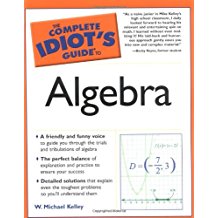Algebra: Behold the Power of Exponents
Behold the Power of Exponents
You may have seen teeny little numbers floating above and to the right of other numbers and variables, like in the expression x3. What is that little 3 doing up there? Parasailing? Is it small because of scale, perhaps because it is actually as large as the earth's sun in reality, but is only seen from hundreds of thousands of miles away? No, that little guy is called the exponent or power of x in the expression, and indeed it has a very powerful role in algebra.
Talk the Talk
In the exponential expression y4, 4 is the exponent and y is the base.
Big Things Come in Small Packages
The role of an exponent is to save you time and to clean up the way expressions are written. Basically, an exponent is a shorthand way to indicate repeated multiplication.
In the language of algebra, x3 (read "x to the third power") means "x multiplied by itself three times", or x · x · x. To find the value of real numbers raised to exponents, just multiply the large number attached to the exponent (called the base) by itself the indicated number of times.
Example 2: Evaluate the exponential expressions.
- (a) 43
- Solution: In this expression, 4 is the base and 3 is the exponent. To find the answer, multiply 4 by itself 3 times:
- 4 · 4 · 4 = 16 · 4 = 64
- Therefore, 43 = 64.
- (b) (-2)5
- Solution: In this case, the base is -2, so it should be multiplied by itself 5 times. Don't stress out about the negative signs. Just go left to right, and multiply two numbers at a time. Start with (-2) · (-2) to get 4 and then multiply that result by the next -2, and that result by the next -2 until you're finished.
- (-2)(-2)(-2)(-2)(-2) = 4(-2)(-2)(-2) = -8(-2)(-2) = 16(-2) = -32
Critical Point
Two exponents have special names. Anything raised to the second power is said to be squared (52 can be read "5 squared"), and anything to the third power is said to be cubed (x3 can be read "x cubed").
You've Got Problems
Problem 2: Evaluate the expression: (-3)4.
Exponential Rules
Once you write something in exponential form, there are very specific rules you must follow to simplify expressions. Here are the five most important rules, each with a brief explanation:
- Rule 1: xa · xb = xa + b. If exponential expressions with the same base are multiplied, the result is the common base raised to the sum of the powers.
| x4 · x7 = x4 + 7 = x11 | (22)(23) = 22 + 3 = 25 |
- Rule 2: xaxb = xa-b. If you are dividing exponential expressions with the same base, the result is the common base raised to the difference of the two powers.
- z7z4 = z7 - 4 = z3(-5)10(-5)9 = (-5)1 = -5
Critical Point
Any number raised to the 1 power equals the original number (x1 = x); so, if there's no power written, it's understood to be 1 (7 = 71). In addition, anything (except 0) raised to the 0 power equals 1 (x0 = 1, 120 = 1). The expression 00 works a little differently, but you don't deal with that until calculus.
- Rule 3: (xa)b = xa · b. If an exponential expression is itself raised to a power, multiply the exponents together. This is different from Rule 1, because here there is one base raised to two powers, and in Rule 1, there were two bases raised to two powers.
- (35)6 = 35 · 6 = 330 (k2)0 = k2 · 0 = k0 = 1
- Rule 4: (xy)a = xayaand (xy)a = xaya. If a product (multiplication problem) or quotient (division problem) or any such combination is raised to a power, then so is every individual piece within.
- (5y)2 = 52 · y2 = 25y2 (x2y3)4 = (x2)4 · (y3)4 = x8y12
- Rule 5: x-a = 1x-aand 1x-a = xa. If something is raised to a negative power, move it to the other part of the fraction (if it's in the numerator, send it to the denominator and vice versa) and change the exponent to its opposite. If the expression contains other positive exponents, leave them alone.
- Most teachers consider answers containing negative exponents unsimplified, so make sure to eliminate negative exponents from your final answer. Also, note that raising something to the -1 power is equivalent to taking its reciprocal.
| x-3y2z3 = y2x3z3 | (42w5)-1 = 42(-1)w5(-1) = 4-2w-5 = w516 |
Most of the time, you'll have to apply multiple rules during the same problem, in your attempts to simplify.
Example 3: Simplify the expression (x2y-3)2(xy2)4.
Solution: Start by applying Rules 3 and 4 to the numerator and denominator.
- x2 · 2y-3 · 2x1 · 4y2 · 4 = x4y-6x4y8
Now apply Rule 2, since you have matching bases in the numerator and denominator.
You've Got Problems
Problem 3: Simplify the expression (x3y)5 · (x-2y2)3.
- (x4 - 4)(y-6 - 8) = x0y-14 = y-14
Finish by applying Rule 5.
- y-14 = 1y14

Excerpted from The Complete Idiot's Guide to Algebra © 2004 by W. Michael Kelley. All rights reserved including the right of reproduction in whole or in part in any form. Used by arrangement with Alpha Books, a member of Penguin Group (USA) Inc.
You can purchase this book at Amazon.com and Barnes & Noble.
